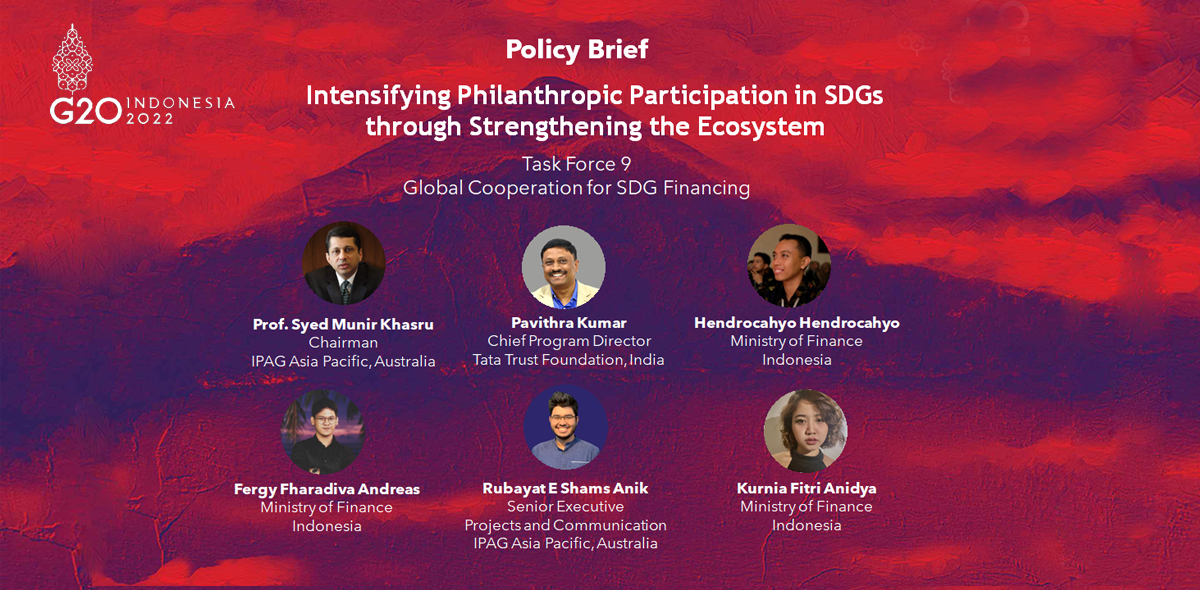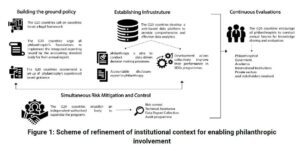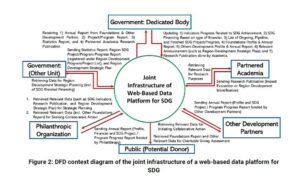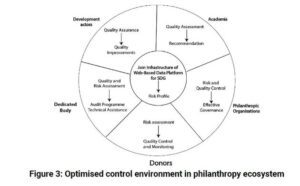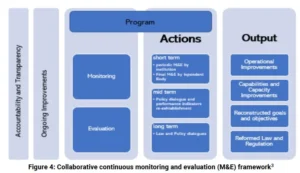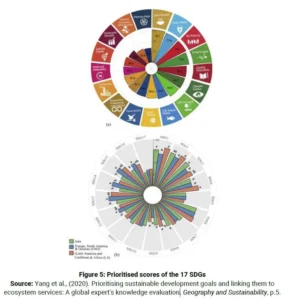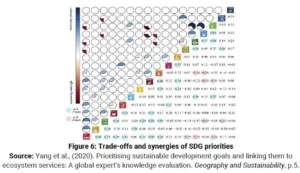Lead Author:
Syed Munir Khasru
Chairman, IPAG Asia Pacific, Australia
Co-authors:
Hendrocahyo
Ministry of Finance, Indonesia
Kurnia Fitri Anidya
Ministry of Finance, Indonesia
Fergy Fharadiva Andreas
Ministry of Finance, Indonesia
Pavithra Kumar
Tata Trust Foundation, India
Rubayat E Shams Anik
Senior Research Associates, IPAG
Link: https://www.global-solutions-initiative.org/policy_brief/intensifying-philanthropic-participation-in-sdgs-through-strengthening-the-ecosystem/
______________________________________________________________
Abstract
Philanthropic foundations play an essential role in sustainable development – not only in mobilising financial resources but also as development actors in their own right. Despite shared goals, governments and foundations have a significant communication and collaboration gap that often results in following parallel paths without engaging in genuine and effective complementary partnerships. Hence, strengthening the philanthropic ecosystem is crucial, creating conducive conditions for philanthropy to thrive. This requires a systematic government approach to collaboration so that governments and foundations see themselves and each other as complimenting each other as equal partners in United Nations Sustainability Goals (SDGs) financing. To do so, there should be a creation of an effective regulatory environment involving relevant stakeholders and enabling philanthropy to have long-term strategic investment towards SDGs achievement.
Challenges
Background
Impact of COVID-19
The COVID-19 pandemic has been one of the most devastating pandemics since the Spanish flu in 1920 (WHO, 2020). The pandemic has not only impacted the health industry but also
created enormous economic hardships globally, setting back a great deal of progress that nations had made – including the United Nations Sustainability Goals (SDGs) Agenda 2030.
As countries suffered from an exponentially growing number of COVID-19 patients, their hospital capacity was stretched thin by an overwhelming number of patients. Doctors and
nurses became worn out, and hospitals faced logistical nightmares and mortality rates spiked. Global mortality rates started climbing back up in 2020 after steadily falling for almost
50 years since 1971 (knoema, 2021).
Impact on SDGs
SDG 3 (Good health and wellbeing) was the most impacted due to COVID-19. About 90 percent of the countries reported disruptions to their essential health services – fearing a loss of a decade of progress in reproductive, maternal and child health, with 35 percent of the countries reporting disruptions, particularly in these health areas (UN, 2021). The pandemic also risked progress in non-communicable diseases and amplifying health inequalities (SDG 10) – out-of-pocket health expenses pushed about 90 million people into poverty (SDG 1) (UN, 2021). The SDG Report 2021 suggests that the increase in global poor was between 119-124 million (UN, 2021). As the pandemic impacted economic activities and cost jobs (SDG 8), poor families will suffer more due to the out-of-pocket health expenses whereby food affordability may be compromised (SDG 2) – an estimated 161 million or more people faced food insecurity when the pandemic hit in 2020 (UN, 2021).
Work with philanthropy: evidence from COVID-19 cases
During COVID-19, the nonprofit sector collected more than US$20 billion globally in response to COVID-19 (Candid, 2021). Through the funding received, philanthropic foundations proved their quick response in collaborating with governments to flatten the curve by providing aid and assistance directly to the most impacted groups (Venkatachalam, et al., 2020; Nowski, et al., 2020; Candid, 2021). Given the rapid action of philanthropic foundations and the positive impact on vulnerable groups, governments need to create a framework to maintain and strengthen the collaborative partnership for achieving SDGs 2030 Agenda.
Inhibitor of collaboration action
Lack of regulation hinders the participation of philanthropy
The Organisation for Economic Cooperation and Development (OECD) (2018) found that vague regulation and rigidity of procedures may hinder governments from perceiving philanthropy as an equal catalyst partner. For example, in Ghana, philanthropists cannot engage in advancing SDG achievement due to the absence of a clear legal framework in the philanthropic sector (Kumi, 2019). Further, even if regulation exists, the complexity of law and regulation has slowed the progress of philanthropists in engaging with local governments due to the time-consuming process of understanding the regulations (Sidhu & Chen, 2020; CAPS, 2022). Besides, strict regulation might harm philanthropic foundations’ fund flow, resulting in resource constraints and internal inadequacies (OECD, 2018; OECD, 2021; CAPS, 2022). Moreover, weak enforcement in governing philanthropic governance might limit the progress of a transparency culture in philanthropy, resulting in a low level of trust, which is counter to enabling collaboration (Sidhu & Chen, 2020; Rickmers, et al., 2020; OECD, 2021; CAPS, 2022).
Absence of effective coordination causes misalignment of mission among development partners
Poorly devised coordination mechanisms slow mission alignment among partners (Sidhu & Chen, 2020). Moreover, this absence of integration hinders the effectiveness of philanthropy. For instance, in Ghana, Kumi (2019) states the lack of a dialogue platform among private, government and foundations resulted in duplication of activities, making development partners’ contribution to the country questionable. On the other hand, the existence of a coordination unit might result in a data-sharing platform for driving social welfare, which would benefit all stakeholders, including philanthropic foundations to make strategic spending (OECD, 2018; Susha, et al., 2019; Roussel, 2019; Kumi, 2019; Sidhu & Chen, 2020; OECD, 2021).
Proposals for G20
Required institutional reforms for enabling philanthropic involvement “Government, philanthropists and nonprofit organisation around the world need to step up and respond on a scale like never before to support their communities” – Ban Ki-moon, opening speech at Talking Philanthropy 2021 Asia-Pacific: Supporting A Philanthropic Ecosystem,
It is crucial to address evolving social challenges under field-based thinking, which requires a paradigm of collaboration to achieve societal goals (WINGS, 2018). The SDG Philanthropy
Platform (SDGPP), a pilot project which operates in Kenya, Columbia, Indonesia, Ghana, the United States, Zambia, India and Brazil, is an example where multi-stakeholders can collaborate
in the planning, implementation and monitoring of SDGs within countries (Callias, et al., 2017). In addition, the platform has allowed philanthropy to engage with government and other partners,
resulting in effective funding (Reisman, et al., 2017).
Following the practices of the SDGPP and the guidelines for effective philanthropic engagement initiated by the OECD and a significant number of philanthropic actors, we recommend a refinement of countries’ institutional context through 1) building the ground policy, 2) establishing joint infrastructure of a web-based data, 3) simultaneous risk mitigations and control, and 4) continuous evaluation.

Policy framework for philanthropic ecosystem
Regulation is essential for philanthropists to showcase their role as intermediaries in positively impacting society (CAPS, 2022). Supporting that notion, Wiepking et al. (2021) found that empirically when organisational and societal structures support philanthropy, people are more likely to give higher amounts to philanthropic organisations. In that spirit, the Group of 20 (G20)
should encourage countries to re-assess their legal framework related to philanthropic involvement through a stakeholder mapping approach which will help the governments identify the need for philanthropy and modify current regulations to become compatible with a country’s characteristics.
On that note, governments could 1) introduce a new tax-exemption scheme for charitable funds supporting SDG achievement, 2) revise regulations related to philanthropic registration and cross-border funding, 3) set up a regulatory body for nonprofit organisations, 4) create laws supporting philanthropic participation in national/subnational development planning, monitoring and evaluation, 5) create reporting standards tailored explicitly to philanthropy foundations’ unique transactions and economic events; for instance the International Financial Reporting for Nonprofit Organisations (IFR4NPO) that is currently in operation (Sanderson, 2021) can be endorsed by the G20 by encouraging countries to get involved in process creation also during the adaptation phase to ensure that standards satisfy the need of all types of foundations, and 6) create guidance mechanisms derived from existing regulations, as well as open to collaborative procedures, highest standards of professional ethics and adaptable to countryspecific ground realities and best practices.
Establishing a systematic joint infrastructure
A database comprising data from different actors in relevant fields could bring positive societal impact as it would better portray the status quo (Bixler, et al., 2018; Roussel, 2019; Susha, et al.,
2019; UNDP, 2020). The Kenyan government has followed this idea by creating the Kenya Data Forum as a platform for data sharing that allows philanthropic and other stakeholders to engage
with the government during development planning. Following these practices, the G20 should encourage countries to provide a data platform for SDGs that enables all relevant actors to get
involved (Figure 2). This platform must be web-based, as its architecture will allows the keeper to centralise and control information and provide quick access to inform the end-user (Abdullah,
et al., 2018).
The proposed interface of the web-based data platform would be an adaptation of the existing dashboard such as SDGFunder by Candid, Shared Data by the Foundation for Shared Impact (FSI), Private Philanthropy for Development: Data for Action dashboard by OECD, and Global SDG Indicators Data Platform by the UN. The web-based provision of information would include 1) current progress of each SDG shown by relevant statistical indicators, 2) current amount of financing of each SDG based on the financier, 3) a list of ongoing and pipeline programmes, including their progress 4) profile of regional foundations linked to their websites, 5) profile of other development partners linked to their websites, 6) government publications (including but not limited to press releases, guidance and regulations related to financing procedures) and 7) list of research publications by partnered academia.

The accessible information would help actors, as the users, in the decision-making process. For instance, 1) government could use the data for the identification of prioritised sectors, budget allocation, and potential financiers for SDG blended-financing implementation, 2) philanthropic foundations and other development partners could use the data for strategic planning, budgeting, spending, learning, evaluation and identifying potential collaborators, 3) academia could use the data for research purposes, and 4) the public could use the data for increasing
awareness.
Managing risks of SDG programmes funded by philanthropic organisations.
Despite the appreciation of philanthropic organisations for generating the common good, without a proactive attitude to inform and engage with society, the organisations risk arousing suspicion about their accountability and transparency (Strachwitz & Alter, 2020). Adding to that notion, potential donors may perform risk and loss aversion behavior, negatively affecting the maximal potential impact of philanthropic funding (Ettinger & Ettinger, 2015). Similarly, the Open Road survey in 2015 shows that out of 200 randomly selected donors surveyed, 76 percent did not ask potential grantees about possible risks to the project. In addition, grantees reported that 87 percent of the applications did not ask for risk assessments1. Donors are eager to engage with charities aligned with a quality auditor (Kitching, 2009). Small nonprofits and philanthropic organisations generally have refinements of audit fee models instigated by agency problems and signaling effects due to the absence of stakeholders (Verbruggen, et al., 2011). Therefore, internal and external audits are needed to ensure the reliability of accounting information in nonprofits (Maguire, 2014).

As the philanthropic ecosystem grows in complexity, the coordination between stakeholders involved relies on an effective control environment (see Figure 3)2. This controlled environment will 1) achieve its strategic objectives, 2) provide reliable financial reporting to internal and external stakeholders, 3) operate its business efficiently and effectively, 4) comply with all applicable laws and regulations, and 5) safeguard its assets (Schandl & Foster, 2019). Hence, the G20 calls on all relevant stakeholders to create effective risk management. To do so, a dedicated body should be established to provide technical assistance and assurances services, especially for small philanthropic organisations. In addition, this autonomous body will perform audit and data analytics of SDG programmes processed by the joint-infrastructure web-based platform (see Table 1).

Continuous monitoring and evaluations of SDG programmes
The SDGs place a high value on transparency for the accountability of institutions (Kumi, 2019). Attention has been brought to focus on implementation, monitoring and evaluation. For the SDGs to succeed, every level of government will be counted on to benchmark and assess progress on each goal (Woodbridge, 2015). Continuous monitoring and evaluation of current programmes will ensure that corrective action remains on track on a timely basis. Additionally, this generates an assessment of the effectiveness of ongoing and proposed programmes in achieving objectives and identifies areas needing improvement through programme modification (Steiss, 2003). However, most nonprofit and government programmes are not set up to do a continuous evaluation for mid-implementation adjustments (Miller, 2017). At the global level, the initiative of the High-Level Political Forum on Sustainability (HLPF) has become a platform for national leaders to align their mission towards SDGs and to voluntarily report the progress of the 2030 Agenda in each country. Supporting the practice of the HLPF, the G20 should advocate for countries to conduct similar monitoring and evaluation at the national and subnational levels involving philanthropic organisations, development actors and governments. Further, a policy dialogue should be conducted by inviting international communities, academia, philanthropic organisations, and other stakeholders as a follow-up evaluation of SDG programmes.

Recommendation for philanthropic financing post COVID-19
Strategic approach towards most-impacted SDGs
The COVID-19 pandemic devastated the global health sector leading to a loss of decades-long SDG progress (UN, 2021) – particularly SDG 3 (Good health and wellbeing). As the global health
industry is now recovering, there needs to be a focus on regaining momentum on the track to succeed in the SDGs Agenda 2030.
In the United Kingdom summit in 2021 of the leaders of the Group of Seven (G7) largest seven economies the intellectual property rights for the COVID-19 vaccines were waived so that
countries could produce the vaccine without paying royalties (EU, 2021). The leaders also committed to $8.7 billion in vaccine donations and assumed responsibilities for strengthening
the global health and health security architecture (European Council, 2021) – pushing the recovery progress in SDG 3.
The G20 should collaborate with such actions and strategies undertaken by world leaders, be it at the G7 Summit, COP26 or the UN. While the rich nations representing the G7 can donate
money themselves (European Council, 2021), developing nations might not be able to do the same – especially when they are recovering from the pandemic themselves. This is where the
G20 can use a guided-philanthropy strategy to direct large cumulative funding towards the most impacted SDGs. The strategy can be coordinated with leaders of the developed G20 nations to
guide global philanthropy.
Prioritisation of SDGs
Guiding philanthropic funding towards the most-impacted SDGs is necessary for post-pandemic for recovering the progress of the SDGs, especially at a time when funding for SDGs is limited
due to countries focusing on their own recovery from the COVID-19 pandemic. SDG funding is facing a shortage of $1.7 trillion due to the COVID-19 pandemic, a shortage unlikely to be
subsidised by governments as about 90 of the 122 developing countries are still recovering from pandemic-driven recession (OECD, 2021).
According to the journal Geography and Sustainability, SDGs were scored and ranked according to their prioritisation, with SDGs scoring more than 65 labelled as most important, SDGs scoring
between 59.6 and 49.3 were labelled as of moderate importance, and the ones that scored below 49.3 were labelled as low importance. At the global level, the most important was SDG2 (Zero
hunger, 78.7), and the least was SDG17 (Partnerships, 34.3) (Yang, et al., 2020).
According to figure 5 (Yang, et al., 2020), the most important SDGs ranked from the top are:
i. SDG 2 – Zero hunger (78.7)
ii. SDG 6 – Clean water (77.8)
iii. SDG 1 – No poverty (76.1)
iv. SDG 3 – Good health (73.2)
v. SDG 4 – Quality education (66.6)
vi. SDG 13 – Climate action (66.3)
vii. SDG 15 – Life on land (65.0)

The scoring was also done separately for three global regions: Asia (A), Europe-North AmericaOceania (ENO) and Latin America-Africa (LA). Across these three regions, LA was significantly
behind in SDG 4 (Quality of education) compared with other regions. In addition, both A and LA regions suffered more from SDG 1 (No poverty), SDG 3 (Good health), SDG 8 (Economic growth),
and SDG 9 (Industry innovation) compared with the ENO region (Yang, et al., 2020).
SDG 1 (No poverty) and SDG 3 (Good health) are of significant importance, not only globally but also in the developing regions of Asia, Latin America and Africa – the regions which are
struggling to acquire adequate financing for pursuing SDGs.
Focused SDG financing
SDGs 1 and 3 are of significant importance not only due to the pandemic impact on their progress but also because the progress of these goals are being hampered in developing regions which particularly are struggling from lack of financing due to everyone trying to recover from the pandemic. Other SDGs can also be aimed to improve progress in SDGs 1 and 3 as there are high synergies among a few pairs of SDGs (Yang, et al., 2020). According to Figure 6, among the ones with high synergies are SDGs 1 and 3 (0.51), SDGs 1 and 2 (0.48), SDGs 1 and 8 (0.45), SDGs 1 and 5 (0.43), SDGs 3 and 4 (0.42). This means that by aiming for SDG 1s and 3, it is also possible to significantly improve the progress of SDG 2 (Zero hunger), SDG 8 (Economic growth), SDG 5 (Gender equity), and SDG 4 (Quality education) (Yang, et al., 2020).

Financing for the local community
While guided philanthropy is necessary for driving the current challenges of the SDG financing shortage, it is essential to lead a community-driven approach to achieve the SDGs. As local communities are among the most impacted groups by COVID-19, implementing the financing through them is vital to pursue more effective output. For instance, as smallholder farmers – of whom 43 percent are women – produce 80 percent of the world’s food4, driving the local agricultural community will improve the standard of living of farming families, alleviating poverty,
reducing hunger, alongside empowering women. This will enable the achievement of multiple SDGs, such as SDGs 1, 2, 3, 5, 8, 10, 12, 13 and 15 (Abraham & Pingali, 2020).
Conclusion
The G20 should ensure countries have unilateral goals in accelerating SDG achievement by 2030, including seeing philanthropic organisations as their catalysts and equal partners. Strengthening the philanthropic ecosystem will guide philanthropic organisations to enable them to contribute to achieving SDGs, especially by allowing them to formulate strategic funding to the SDGs most impacted by COVID-19 and driving local communities.
